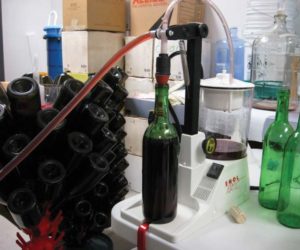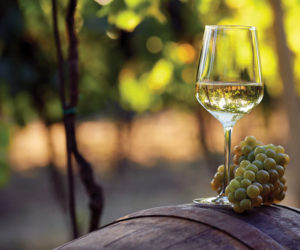
Q
I have been making wines for more than 20 years, but I have a problem with initial sugar determinations, added sugar requirements and subsequent alcohol content. Hydrometer readings on the initial crushed fruit may be way off, depending on how well the crush goes. Much could still be locked up in the uncrushed portion, especially on plums, cherries, and other hard to crush fruit. Would destoning, say one pound, and running the pulp through a blender and checking the specific gravity on the strained juice give a fairly accurate sugar content? Should I deduct a certain percentage for non-sugar solids?
Ray Ruthenberg
Galena, IL
A
You’ve hit the nail on he head — a hydrometer reading does depend on the amount of suspended solids in the juice that you’re measuring. As sugar is more dense than water, the more sugar (the riper your fruit is) in the juice the higher up the hydrometer will float in your sample. It’s easy to see that if you’ve got lots of little bits of suspended pulp helping the hydrometer to float well above what would be its natural level you’re going to get an artificially high reading. This is why it is so important to measure juice that has as little suspended solids as possible. I don’t recommend you invest in a battery of strainers, settlers and centrifuges. That would be silly because if you follow the tips below you will have juice that is just fine to measure — the extra degree of precision that these tools of paranoia could buy you would be minimal indeed and certainly not worth your time or money.
I always always follows the same procedure when checking my sugars: soak, sample, strain and squeeze. When you receive a load of fresh grapes, cherries, plums or any other fruit that you’re going to ferment, go ahead and crush the fruit in prep for fermentation as you normally would. First you soak. Let the fruit and juice macerate for 12 to 24 hours — this step is key! Freshly-breached cell walls will not release all of their soluble carbohydrates just because you want them to! It takes time. After you’ve waited for the majority of the sugars to be released into the surrounding environment (that’s the juice to you and me), stir up your container (be it a 5-gallon bucket or a 50-gallon drum) and scoop yourself out a nice, sloppy sample, about 3 cups worth. Make sure you’ve stirred it up well beforehand and that you’ve got some of the chunky stuff in there too. Put the whole gloppy mess into a large strainer you’ve lined with 2 or 3 layers of cheesecloth. Strain the liquid out and give the solids in the cheesecloth a very gentle squeeze, just until the juice coming out stops being a steady stream and begins to come out in drops. Being gentle is the key. If you’re forceful, a lot of the solids will find their way out of the cheesecloth bundle into your sample — just what we’re trying to avoid! Similarly, you wouldn’t want to blend up the sample as this would just be mincing the solids up even further, incorporating them even more into the juice, making what for all intensive purposes would be a fruit smoothie — nice, thick and definitely not an accurate representation of the density due to sugar in the juice itself.
At this point you should have enough juice to give you a pretty representative sample which you could go ahead and measure. If you wanted to be particularly accurate (like if you’re going to have to add sugar and you want to know how much to ameliorate) you could then let the sample settle for another 12-24 hours in the refrigerator. We don’t want any spontaneous fermentations happening here! Siphon the clearest juice off of the top and then measure that. When you’re making a wine where you’re just going to be fermenting the juice and not the pulp, you’ll go through a settling stage post-press anyway, so your sample will be more precise. Always be sure to correct hydrometry readings for temperature. Warmer liquids are less dense than colder ones and will always give different density readings even if they’re of the exact same chemical composition.
Refractometers measure the amount of sugar by bending light through a prism in a way that correlates to the refractive properties of the juice. Again, a clear sample will yield the most accurate results. Refractometers are quick and easy, but are expensive.
Q
I raised the TA of the must from 0.5 to 0.6 at the beginning of fermentation for my red wine. Should I still add malolatic bacteria to start MLF knowing that it will reduce the TA?
Tony Querio
Troy, Michigan
A
For most homemade red wines, actively encouraging the malo-lactic fermentation (MLF) is a good thing as it can add some flavor complexity and also stabilizes it against post-bottling MLF (always a fizzy catastrophe) by pre-emptively getting rid of the malic acid present in the wine. As opposed to starting MLF concurrent with fermentation, I suggest adjusting your acid pre-primary fermentation, see your wine healthily through primary and then check the acid again once primary is complete. Primary fermentation will typically lower a TA — be sure to de-gas your sample before you run the analysis!. If it’s not totally low (say, under 5.0 g/L, go ahead and put the wine through MLF and see where the acid comes out. If you need to adjust up to get it to that point, go ahead — you don’t want any “bad” bacteria (like acetobacter) taking advantage of a low-acid situation. Once you are through MLF, you can adjust the acid however you wish. The deal is that MLF bacteria are happier at a lower TA than yeast are, and what will make yeast (and your tastebuds) happy aren’t necessarily the same. For MLF bacteria — when we’re talking about typical wine TA and pH ranges — the lower that you are comfortable to go, the better. (For more information see “Acidity” Spring 2001, and “pHiguring out pH“, Summer 2001.)
MLF is a series of metabolic reactions carried out by a group of bacteria commonly called “the malo-lactic bacteria” in which the organism consumes malic acid (di-protic, or with 2 hydrogens and therefore “more acidic”) to lactic acid (mono-protic or with 1 hydrogen and therefore “less acidic”). The byproducts are CO2 and diacetyl. MLF can also contribute other more unhappy-smelling by-products which may spoil a bottle of finished wine. MLF can and often will happen spontaneously at any time during a wine’s life. By depleting the supply of malic acid early on, a winemaker lessens the chance of malo-lactic fermentative spoilage later, when a wine may be ready.







